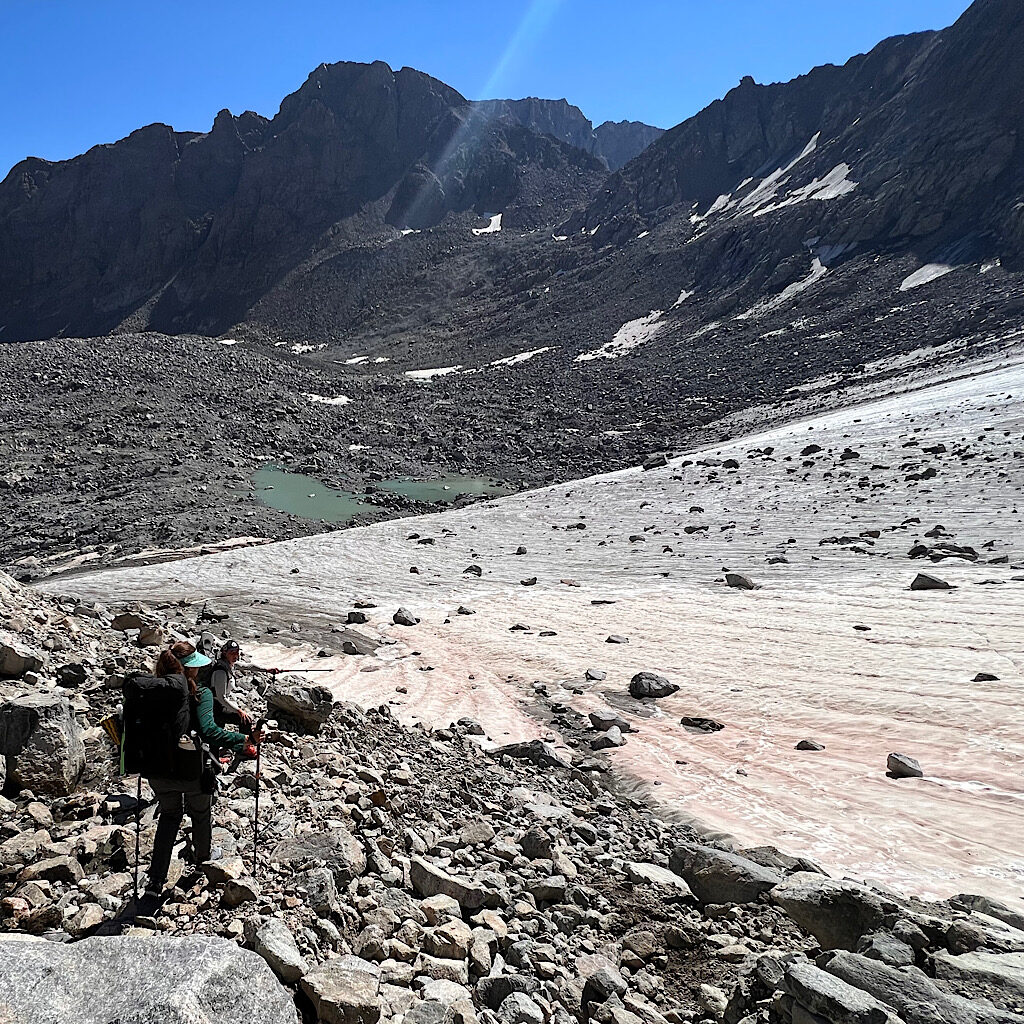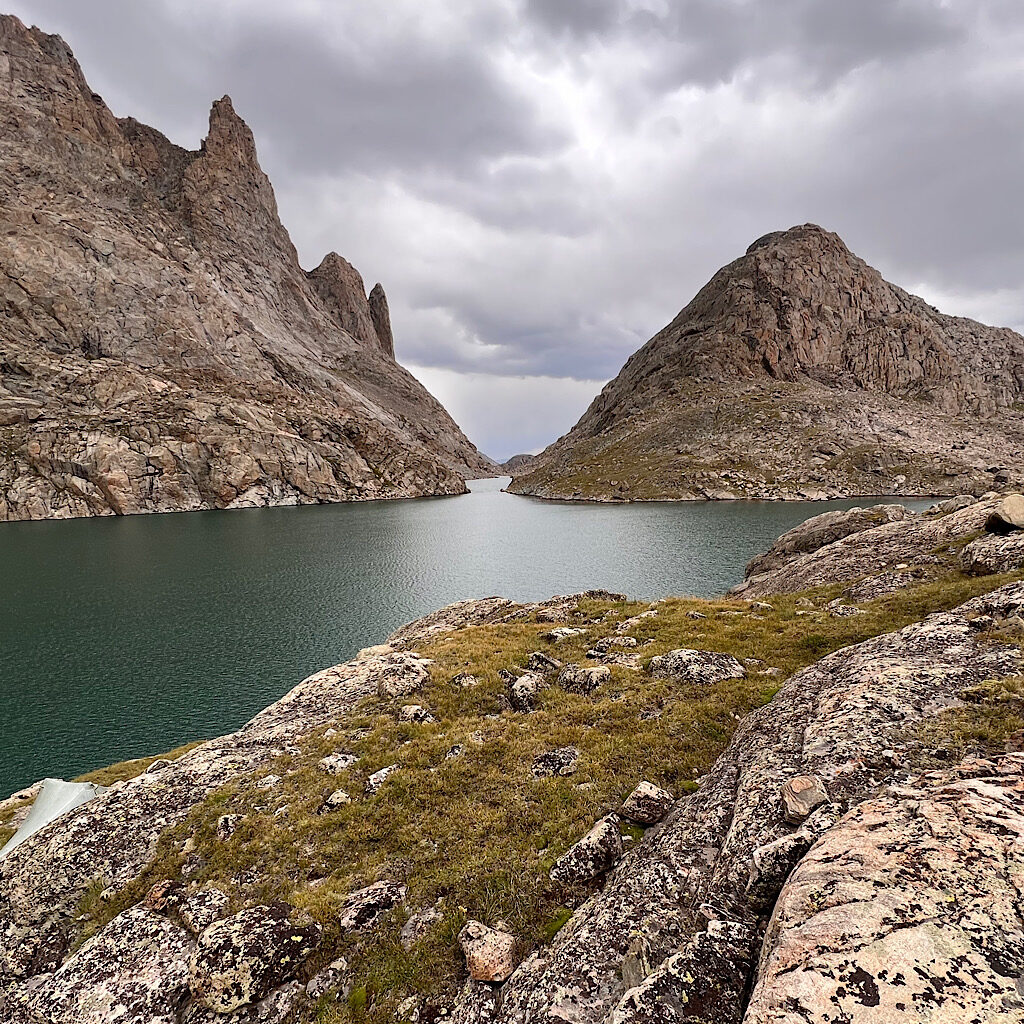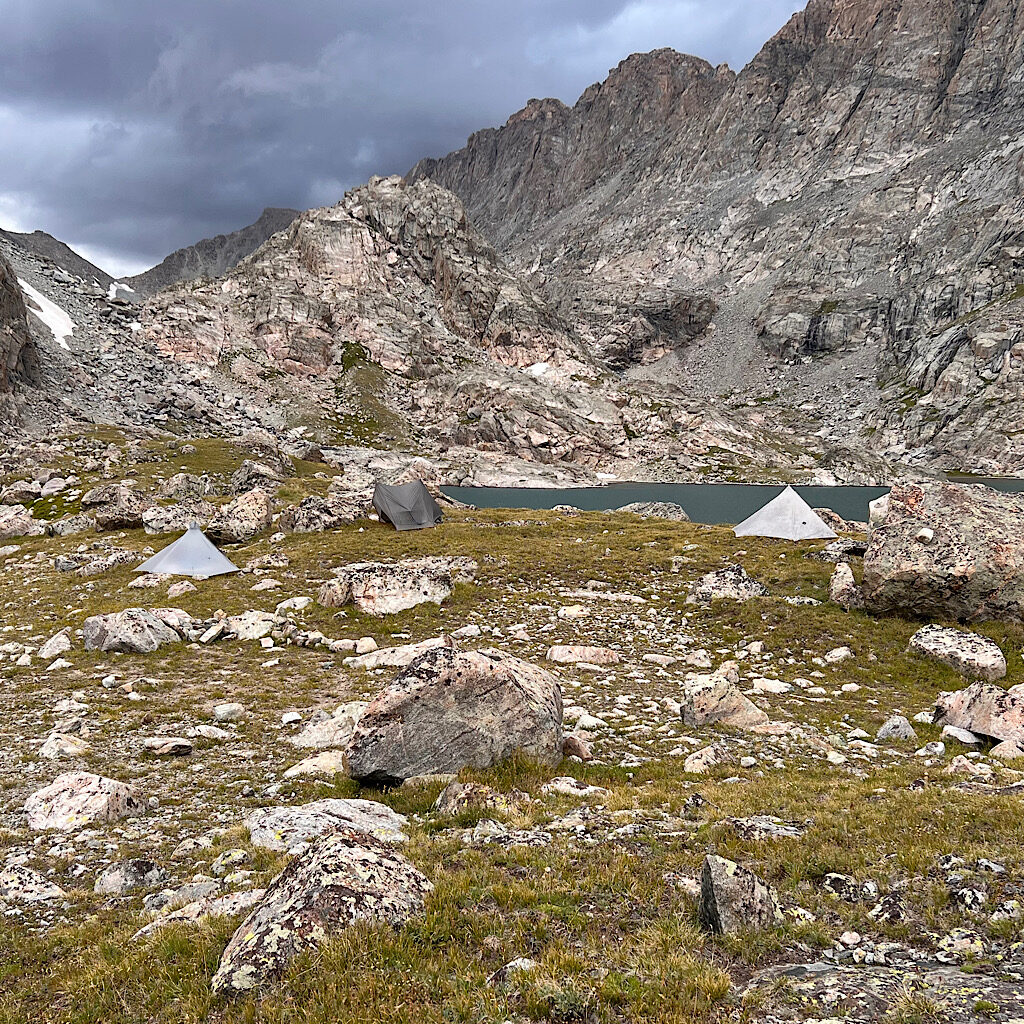
Since Katlyn and I both walked the Te Araroa, we share a few Kiwi expressions: ‘heaps’ as in Today’s walk on the Wind River High Route had heaps of talus grinding our forward progress to less than a mile per hour and ‘hard as,’ which pretty well described all of the route start to finish.
Well, that’s not entirely fair since the start from our sweet peninsula camp begins on traditional tread, obvious trail barely requiring a glance at feet placement. It’s back to 12,000 feet under a crystal sky, a sliver of moon setting behind the massive hunk of Fremont Peak.
The views into Indian Basin are stupendous, the lakes puddles from here under towering rock in shades of blue to the horizon, the high desert beyond. Our camp is below and I laugh thinking how much I love seeing the tiny coffin shape dry patch of grass when I take down the alicoop (my tent) How safe and warm I was last night even with rain in this extreme landscape.
The trail curves up and around looking deep into a canyon I can’t imagine anyone visiting, peaks shooting straight to the clouds, triangular spikes. A wee lake sparkles below.



Over the top, we lose any semblance of trail as we cross from the Western to Eastern Divide, glaciers plastered to a series of mountains. It’s all boulder balancing now to carefully lose altitude and reach the sweet spot of 11,600 and cross the glacier.
What glacier? I wonder not seeing it until we descend quad burning step by step to a saddle. Oh, that glacier! It’s hidden behind more rocks tumbling down this slowly eroding mountain, huge, gleaming, stretching from high up on the cliffs down to wee silty lakes below.
A hiker comes up seemingly from nowhere and tells us he traversed in his sneakers – very carefully. He also warns us to stay on glacier as long as we possibly can. As global warning melts the glaciers quickly, the surrounding boulders haven’t had time to settle. They’re loose in a muddy gumbo of ice and water.
I found out just how unsettled things are sliding on a muddy face and loosening an avalanche of suitcase-sized rocks towards a more solid looking boulder. No harm, no foul, but the speed with which things happen leave me a bit shaken.


My solid boulder makes an ideal seat to attach microspikes and pull out the axes. Katlyn wisely uses one trekking pole for balance too and we slowly navigate onto the ice. Almost immediately, Kelly loses a water bottle which fortunately skids to a stop within reach.
The angle is not great (yet) but spikes give us the confidence to glide fluidly over crusty ice, hundreds of streams coursing down in snakelike channels. Boulders perch precariously above, sometimes on ice stands. Will these ice bridges hold? How about those rocks bigger than me?
It’s fair to say the added weight of snow tools is well worth it. Especially when the angle sharpens and the ice hardens. The glacier itself hangs above and a crevasse opens up, easily stepped over. My feet touch ice, soft, then crunchy, wet, then dirty. The sky is lapis.
And just like that, the ice disappears replaced by mud and the aforementioned unstable rock. Forgive me that no pictures were taken here. Was it because I wanted to simply hold the experience dear to my heart or more likely, every bit of my body is required to stay upright.
This is not a familiar kind of mud to just plod through. Rather it’s piles and piles and piles of rock, shifting and threatening to tumble right out from under our weight. And it’s exhausting inching along, each rock a different size and shape. Hands get in on the action, butts, the pointy bits of our tools until after an hour of frustration, things seem to stabilize somewhat.



We take off our spikes, secure the axes and slowly work our way through a maze of rock to where we see people come down the pass. They’re flying down and choose another route out, but their speed cheers us.
It’s a thin trail ‘suggestion’ with a tad more friction, only small, ball bearing stones in a direct line to Alpine Pass. It’s heavy breathing the entire way, but climbing is easy because you really just hurl yourself forward.
It takes us to a fairyland of a glacier-scoured basin, a necklace of aqua lakes flowing into the distance far below. Katlyn finds a ‘couch’ on rock and we bake in the sun eating lunch,
thirsty for water which lies far below.
From here, a glacier shoots off like a lolling tongue, steep and too dangerous, so we opt for the talus slope – solid, settled, unmoving. I’m amazed I move so well across it, I mean down it, steeply dropping to the lakes. It’s stupendous beauty, but all erosion and change in action.
Katlyn begins a philosophical talk about talus, all of it so different that a culture living with it on a daily basis would have different names for each type. Ours so far include mover, shaker, shifter, wobbly, solid.
Merriam Webster describes talus as
- 1: a slope formed especially by an accumulation of rock debris
- 2: rock debris at the base of a cliff
Debris gives the false impression it’s simply broken shards of stone to march over when in reality it can be as large as a house with deep cracks opening between. A phone, a water-bottle, your foot (and its delicate talus bone) can slip between and end a trip then and there.



The descent looks impossible, but the rocks hold solidly and we drink from a waterfall cascading loudly from the glacier above. I may not have pointed out that we are walking a route developed by “Adventure Alan” Dixon with a friend. As one if the original ultra-light backpackers, I interviewed him on the Walking Distance podcast to share insights about the gear he packs. He’s a cool guy and was less of a ‘gram weenie” than I’d expected.
There’s another much harder high route that stays closer to the divide with terrifyingly precipitous drops from knife edges and likely far more talus than I want to think about. People have told us they prefer this rout, though, one that still touches grass every now and then. It’s certainly challenging enough and it would be nice to succeed.
From Alan’s description, I had thought this downclimb would be the worst, but that was still to come.
Ahead are two impassable cliffs dropping deep into the azure lake (technically Lake 11,335)
Although we’re warned all of this will be tedious, he leaves out some details like a steep climb back up over the first cliff on large talus, each step a negotiation. The rock itself is grippy, but our packs make us top heavy. Our calves burn from the sharp angled ascent and the quads tighten up from try to stay balanced.
Sometimes I go well, finding just where to step and skimming over the jumble. Then I’ll need to sit down and slide on my ass to ensure I don’t drop into one of the deep holes. I try to put out of my mind what breaking so many bones at once will feel like.
Boulder to boulder to boulder to boulder – and we’re there! Where? A Class 3 “ramp system.” Scrambling is divided into classes with 3 meaning the terrain is serious and the consequences are real. The moves may be moderate, but they’re on loose rock and the holds are small and hard to find.



Tufts of grass seem to guide us steeply up and around a sheer cliff with only a glance at exposure (true exposure would make this scramble a class 4) Kelly crashes down off one and scrapes her hand, not too badly but she tells us it hurts. I try to downclimb so my pack won’t throw me off and end up needing Katlyn’s knee to make the hold.
Just as I wonder about climbing above all this challenge, we’re ‘cliffed out’ and need to ascend using our hands like a ladder in the air. I pass my sticks to Kelly as I hug a wall, trying to keep the bag out and not touching so as to throw me off balance.
Katlyn certainly was the best invitee with her experience and love for talus.A few more tossed sticks and sliding ramps bring us to giant boulders and the pace slows to a crawl. Hey, at least I’m moving.
I hold my own with women who could be my daughters – and also feel so relaxed and full of joy. It’s hard going now to the outflow of this first lake and another fill up of water. A man camping here and coming the other way helpfully tells us to go straight through the boulders, saving us another cliffing out.
Talus, gullies, drops, ramps and many, many choices bring us to the middle lake (Lake 10, 988) sitting flush with cliffs, encircled by mysterious mountains made even more-so by the gathering clouds. A bay opens across the lake as we climb onto a grass meadow. Like a Scottish loch, I expect to see castle ruins. Fat ruddy-red crickets click past. Picas squeak. Another loud waterfall cascades from a nearby glacier where we collect water before a loud clap of thunder encourages us to set up camp.


2 Responses
Fabulous pictures! Scary as hell! You ladies are incredible!
ha! I did fall twice and slowed WAY down 🙂